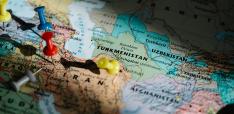The European Union and the erosion of liberal peace: navigating peace efforts in an illiberal world

In this chapter, Elena Conde explores how peace-building models advanced by authoritarian states and the Trump administration challenge the EU’s liberal paradigm. The chapter is part of a forthcoming e-book by the Global Governance Research Group of the UNA Europa network, “The European Union in an Illiberal World.”
The liberal international order, established after World War II and strengthened following the Cold War, has been central to peacebuilding and conflict resolution (Lewis, 2022). The European Union (EU), as both a normative and institutional actor, has consistently promoted liberal peace, based on democratic governance, the rule of law, the market economy, and multilateral cooperation. However, this liberal framework now faces major challenges due to global shifts such as rising authoritarianism, populism, geopolitical fragmentation, and growing distrust in multilateralism (Richmond et al., 2011).
The second Trump administration (2025-2029), combined with the increasing global influence of illiberal powers like China, Russia, Türkiye, and Gulf States, threatens the liberal foundations of current peace processes by undermining international legal norms, introducing alternative mediation actors, and altering post-conflict governance principles.
In this context, the EU must reconsider its role in peace processes and how it can continue to promote peace in a world where liberal norms are contested and illiberal powers are gaining influence. This chapter explores the liberal order’s foundational role in peacebuilding, the threats posed by illiberal actors, the impact of President Donald Trump’s foreign policy, and the EU’s involvement and future prospects in peacebuilding.
The rules of the liberal order and their impact on peace processes
Peace processes can be defined as structured attempts to resolve radical disagreement between conflict parties (PeaceRep, 2024). With such an ambitious aim, they are complex and multidimensional, involving the cessation of hostilities, negotiation among actors, and long-term strategies for reconciliation and reconstruction.[1] The liberal peace model links democracy, free markets, and civil society to stability, with international institutions supporting transitions. It shaped post-Cold War interventions in places like the Balkans and sub-Saharan Africa, promoting inclusive governance, human rights, and institutional reform. Peace, in this view, means more than ending war—it requires building a democratic, market-oriented order that tackles the root causes of conflict (Parsons and Wilson, 2023). This model, for example, shaped international engagement in Colombia’s peace process, supporting the 2016 Agreement with FARC through a focus on transitional justice, reintegration, and rural development—priorities supported by the UN and EU (Regjeringen.no, 2024). Similar strategies were applied in post-conflict Liberia, Sierra Leone, and East Timor, where international actors promoted democratization, the rule of law, and market reforms. These cases illustrate how liberal peacebuilding became the dominant post-Cold War intervention framework.
Despite its strengths, the model has drawn criticism. Scholars highlight its technocratic, top-down approach and tendency to impose Western norms while neglecting local agency (Rampton and Nadarajah, 2017). Moreover, in today’s geopolitical context, liberal peacebuilding faces growing challenges from actors advancing alternative models rooted in sovereignty, authoritarianism, or transactional diplomacy.
The rise of new illiberal powers and their idea of “peace”
Since the 2010s, powers such as China, Russia, the Gulf States, and Türkiye have promoted peacebuilding models that differ from the Western liberal paradigm. These alternatives emphasize sovereignty, regime stability and strategic interests over democracy and human rights, often relying on “minilateralism” (Whitfield, 2025). Despite different motivations, they share a focus on bilateralism, authoritarian stabilization, and maintaining existing power structures, challenging liberal peacebuilding (Call and de Coning, 2017).
China: infrastructure-for-peace and sovereignty over rights
China’s model centers on economic engagement and non-interference, known as “developmental authoritarian peace.” Through the Belt and Road Initiative (BRI) launched in 2013, China prioritizes infrastructure over governance reform. In conflict-affected states like South Sudan, China combines UN peacekeeping with oil investments and elite deals, reinforcing the status quo despite violence (International Crisis Group, 2017). In Myanmar, Beijing opposes sanctions and supports bilateral cooperation, protecting the military regime amid the Rohingya crisis (Hossain and Obaidullah, 2025).
Russia: militarized peace and strategic fragmentation
Russia has adopted a coercive, militarized peace model based on military intervention, elite co-optation, and strategic fragmentation, aiming to preserve influence in post-Soviet regions while undermining Western governance models. This was evident in Syria in the mid-2010s, when Russia ensured President Bachar al-Assad’s survival, and sidelining UN-led efforts (Lewis, 2020). In Ukraine, from Crimea’s annexation in 2014 to the 2022 full-scale invasion, Russia has used military force, diplomacy, and disinformation to assert dominance, challenging the rules-based international order. Through negotiation efforts like the Minsk agreements, Russia imposed conditions undermining Ukrainian sovereignty, shaping a hierarchical peace aligned with its strategic interests (Soldatenko, 2025). This approach prioritizes authoritarian stability and regime security over democratic inclusion or justice. It excludes civil society and reflects a peace based on domination rather than reconciliation. As of 2025, Russia’s continued demands, including recognition of annexations, Ukrainian neutrality, and the lifting Western sanctions, with no concrete ceasefire commitments, show its illiberal peace model prioritizing strategic dominance (Geopolitics, 2025).
The Gulf States: authoritarian stabilization and geopolitical patronage
The Gulf States, particularly Saudi Arabia and the UAE, pursue authoritarian stabilization through military interventions, financial aid, and infrastructure investments aimed at suppressing democratic movements, countering rivals like Iran and the Muslim Brotherhood, and strengthening strategic alliances (Ziadah, 2021). After Egypt’s 2013 coup, Gulf monarchies have supported President el-Sisi with much aid, reversing Arab Spring gains. Their 2015 intervention in Yemen, initially intended to restore the government, resulted in prolonged conflict and humanitarian crisis.
Türkiye: strategic peace through military and cultural projection
Türkiye promotes a hybrid peace model combining humanitarian diplomacy, religious and educational outreach, and military engagement. Under President Erdoğan, peace efforts have served to expand Türkiye’s influence in North Africa, the Eastern Mediterranean, and the Caucasus (Arco and Moussa, 2024). For example, Turkish support for Azerbaijan in the 2020 Nagorno-Karabakh conflict shifted power balances and sidelined the OSCE-led framework (Avdaliani, 2020). In Libya, Türkiye’s 2019 intervention backing the Government of National Accord (GNA) was framed as support for legitimacy but also secured strategic gains, including maritime and energy rights in the Eastern Mediterranean (Yüksel, 2021).
Resource diplomacy and illiberal peace: the Trump administration’s challenge to international norms
Since the start of President Trump’s second term, United States (US) foreign policy has embraced a transactional, unilateralist model that sidelines liberal peacebuilding. Peace initiatives are framed as strategic deals, subordinating collective norms to narrow national interests. Thus, his revived bid to acquire Greenland (including annexation threats) ignores Danish sovereignty and indigenous rights, reflecting a resource-driven geopolitics (Chuffart and Johnstone, 2025). This logic is also evident in Ukraine, where US aid is now tied to access to critical minerals like lithium and titanium (Baskaran and Schwartz, 2025). In Gaza, the US has aligned with Israel’s militarized approach, backing controversial plans for forced displacement and the conversion of the Strip into a “special economic zone”—proposals that contravene international humanitarian law (Amnistía Internacional, 2025). In the Democratic Republic of Congo (DRC), the US has linked military support to privileged access to cobalt and other minerals, sidelining inclusive reconstruction and reviving neocolonial dynamics (Baskaran, 2025). In short, diplomacy and aid are instrumentalized to secure resources through coercive bilateralism, challenging previous international norms.
The European Union as a liberal peace provider
In the context of liberal peacebuilding, the EU has emerged as a key normative and operational actor. Through the Common Foreign and Security Policy (CFSP) and a variety of Commission tools (e.g., the Service for Foreign Policy Instruments (FPI), the EU Delegations, the European External Action Service (EEAS), and the Neighborhood, Development and International Cooperation Instrument – Global Europe (NDICI-Global Europe)), the EU takes a comprehensive approach to conflict, as outlined in the Global Strategy for the EU’s Foreign and Security Policy (2016). Its engagement ranges from diplomatic mediation to electoral assistance, institution building, and economic support. Examples of the EU’s peace-oriented engagement include its pivotal role in the stabilization of the Western Balkans, its participation as coordinator of the Joint Comprehensive Plan of Action (JCPOA) with Iran since 2015, and its continued presence in Common Security and Defence Policy (CSDP) missions across Africa, the Middle East, and beyond. The EU has toolkit that blends civilian and military means, normative persuasion, and development aid.
Since adopting its 2009 Concept on Mediation, the EU has strengthened its global role in peace mediation—ranging from high-level negotiations to local dialogue support (EEAS 2021). The 2020 Concept and EEAS Guidelines reaffirmed commitments to human rights, gender equality, and sustainable peace. Structures like the EEAS Mediation Support Team (2011) and the Pool of EU Peace Mediators (2020), along with tools such as ERMES, enhance operational capacity (EEAS 2021). These have been used in diverse contexts: as lead mediator in the Serbia-Kosovo dialogue; in supporting Colombia’s 2016 peace deal; in Mozambique’s 2019 agreement implementation; and in Libya, through technical aid following the Berlin Process.
These efforts are framed by the EU’s broader vision of mediation as a strategic foreign policy instrument aligned with its values and long-term interests. By combining institutional capacity, political leverage, and normative influence, the EU has sought not only to mitigate violence but to address the root causes of conflict and contribute to inclusive and lasting peace. Through this integrated approach, the EU has reinforced its credibility as a multilateral and principled peace actor on the global stage.
Yet, the EU’s model of liberal peace is not free from contradictions. Internally, its credibility has been tested by inconsistent responses to major crises, such as the interventions in Libya (2011) and the conflict in Syria (2011-2025), where the Union struggled to articulate a coherent and unified foreign policy. These divisions reflect deeper fractures among Member States, particularly when it comes to migration and asylum policy. The 2015–2016 refugee crisis revealed sharp disagreements over burden-sharing and the application of common European principles. While the EU framed its response within the values of solidarity and human rights, its implementation exposed deep-seated national resistances. Several Central and Eastern European countries, notably Hungary and Poland, openly rejected relocation quotas and framed migration as a civilizational threat—undermining the liberal narrative from within (Guild et al, 2017).
In addition to this, the rise of far-right and populist parties across Europe has further eroded the EU’s internal normative cohesion. These parties have not only influenced domestic policy shifts toward securitized and exclusionary migration measures, but have also gained growing influence in the European Parliament (Green, 2024). These illiberal trends are increasingly tolerated or even normalized within the EU, revealing institutional limitations in enforcing democratic standards among its members.
Externally, the EU’s ability to project influence is often constrained by its limited hard power capabilities and an overreliance on normative discourse in a global environment increasingly shaped by realpolitik. Its emphasis on dialogue, multilateralism, and legal frameworks often fails to yield tangible results in conflicts where authoritarian actors or geopolitical competition dominate, such as in Syria, Libya, or the Sahel. In these settings, the EU’s normative agenda risks marginalization or instrumentalization, particularly when actors like Russia, China, or even the US now adopt unilateral or coercive strategies that undermine liberal peace norms (Alcaro and Bargués, 2024).
The declining influence of the EU’s liberal peace model in a changing geopolitical landscape
While the EU continues to champion multilateralism, human rights, and inclusive governance, several dynamics reveal the limits of this model (Engelke et al., 2023). Geopolitical marginalization has reduced the EU’s influence in key peace processes, such as the US-led negotiations on Ukraine, where decisions have been made without its full involvement. The rise of bilateralism and coercive diplomacy—favored by powers like the US, Russia, Türkiye, and the UAE—further weakens the EU’s normative leverage, especially where it lacks hard power or access to critical forums (Genini, 2025). Internally, diverging Member State priorities—particularly on China, the US and Israel—undermine coherence and credibility, complicating unified peace efforts (Vinjamuri, 2025). Even in areas of EU strength, like reconstruction and civilian missions, the impact remains limited in complex settings such as in the Democratic Republic of Congo (DRC).
In response, the EU is cautiously adopting a hybrid peacebuilding model that blends liberal principles with pragmatic, interest-driven adjustments—especially in sectors like critical raw materials—reflecting the growing tension between normative commitments and strategic imperatives. The EU’s push for strategic autonomy, especially in green and digital transitions, is evident in the 2024 Critical Raw Materials Act, which promotes supply chain diversification and industrial reshoring (Findeisen and Wernert, 2023). Though framed as sustainable, many partnerships (e.g., with the DRC, Namibia, or Kazakhstan) resemble resource-for-security deals, raising questions about alignment with EU norms. The 2024 Corporate Sustainability Due Diligence Directive (CS3D) mandates human rights and environmental checks across supply chains, but faces political pushback, notably from leaders like Chancellor Merz and President Macron, as the US under Trump lifts similar regulations.
Indeed, the EU’s Global Gateway strategy and recent trade deals reflect a geoeconomic conditionality that ties infrastructure and market access to raw material cooperation, often with authoritarian or fragile states—raising concerns about selective value-based diplomacy (Heldt, 2023). The Lobito Corridor, part of this approach, aims to link Angola, Zambia, and the DRC to global markets, but EU efforts have been undercut by US deals offering military aid for mineral access, highlighting limits to the EU’s influence and the risk of a new resource scramble. The EU’s migration–resource–security partnerships, especially in Africa and the Sahel, now often bypass democratic oversight and risk reinforcing illiberal governance (Human Rights Watch, 2024). Similarly, while promoting liberal peace norms, EU engagement in the Sahel and Eastern Europe increasingly prioritizes security over democratic legitimacy, revealing a growing tension between values and strategic interests (Vasallo Paleologo, 2025).
Finally, the EU’s response to the Gaza war has exposed deep normative contradictions. While some Member States (e.g. Spain, Belgium, Ireland) and figures like former High Representative Josep Borrell and current President of the European Council António Costa have voiced criticism of Israel’s policies, institutional leadership (especially by Commission President Ursula von der Leyen) has faced strong criticism for perceived alignment with US far-right narratives (e.g. Project Esther [2]) amid massive civilian casualties in Gaza (approx. 53,900 deaths by early 2025, including 17,000 children). Despite Israel’s violations of international humanitarian law, a firm EU response has been delayed. This highlights the mediation dilemma: condemning abuses may undermine trust and neutral credibility, yet silence risks moral complicity. In Gaza, as elsewhere, the EU has struggled to balance legal principles with geopolitical interests, revealing a shift toward a more transactional peacebuilding model (Herberg and Banim, 2024).
Conclusion
The European Union finds itself at a pivotal juncture. While it has not formally abandoned the liberal peace framework that has long guided its external action, evolving geopolitical dynamics have compelled a strategic recalibration. The EU’s model—traditionally grounded in multilateralism, the rule of law, human rights, and inclusive governance—is now being reshaped by realpolitik, transactionalism, and geoeconomic imperatives. What is emerging is a hybrid peace paradigm that retains liberal rhetoric but is increasingly shaped by the pressures of global competition, resource diplomacy, and rising illiberalism.
These shifts reflect broader transformations within the international system. The liberal international order no longer enjoys uncontested authority, as alternative governance models promoted by authoritarian powers—such as China and Russia—emphasize regime security, infrastructural development, and state sovereignty over political reform. Simultaneously, within the EU and among its transatlantic allies, populism and skepticism toward multilateralism are straining the internal coherence of liberal internationalism. As a result, the EU’s normative agenda is challenged both externally and from within.
These tensions are especially visible in peacebuilding and mediation. The EU continues to promote liberal principles through its CSDP missions, the NDICI–Global Europe instrument, conditional aid, and support for multilateralism. However, it also pursues bilateral partnerships with states like Namibia, Kazakhstan, or Tunisia, often motivated by urgent concerns—such as migration control or access to critical raw materials—rather than democratic objectives. This pragmatism underscores a growing tension between normative commitments and strategic necessity.
The EU’s limited presence in areas like the DRC’s Lobito Corridor (compared with more transactional US deals) exposes the fragility of its normative strategy. Regulatory initiatives like the Critical Raw Materials Act or the Corporate Sustainability Due Diligence Directive reflect ethical ambition, yet internal disagreements and external competition complicate implementation. The Gaza conflict further reveals these contradictions and EU policy dilemmas: while some EU Member States advocate neutrality to preserve the Union’s credibility as a mediator, others argue that the severity of violations demands a clear stance, and that silence in the face of atrocity undermines normative legitimacy.
In this context, several imperatives emerge. First, the EU must maintain a capacity for traditional diplomacy, particularly as alternative models—such as those advanced by the Trump administration—prove destabilizing. Second, peacebuilding must be linked more clearly to EU security interests: conflicts in regions like the Sahel or Middle East now have direct consequences for Europe. Third, a shift toward discreet, behind-the-scenes engagement may be more effective than highly visible declarations.
Crucially, the EU must avoid compromising its normative foundations in order to compete with value-free actors. Instead, it should reconcile principled engagement with pragmatic flexibility. This entails reassessing internal legal instruments—such as terrorist listings—that may obstruct mediation, and embracing flexible coalitions when full consensus is unattainable. Strengthening internal mediation capacities, including linguistic and cultural competence, is also essential. Where direct involvement is not feasible, the EU can still support alternative mediators and regional organizations through strategic funding and political backing.
In sum, the liberal peace model is undergoing a complex transformation. The EU still possesses substantial normative capital and diplomatic experience. However, unless it addresses the contradictions within its external action, its liberal discourse risks becoming symbolic. Strategic adaptation anchored in principle is essential. Whether the EU can navigate this evolving landscape will shape not only its role as a global actor but also the future of liberal peacebuilding in a contested world.
Elena Conde is a professor of international public law, and a research fellow at the Instituto Complutense de Estudios Internacionales (ICEI), Universidad Complutense de Madrid
This article was finished the 17th June 2025. It is a deliverable of the FEI-EU-25-12 VULNERA (VULNERAbility and International Law in a Changing World) program.
Photo by eberhard grossgasteiger
Notes
[1] The term peace “processes” is normally reserved for situations where two parties are already engaged at the table, eventually with a mediator: for example, the Madrid Conference on the Middle East process in 1991, bringing together Israel and the Palestine Liberation Organization (PLO) for the first time. In contrast, peacebuilding refers to what comes after a peace process has succeeded.
[2] Project Esther is a US initiative launched by The Heritage Foundation in October 2024 to label and dismantle pro-Palestinian activism by portraying it as part of a “Hamas Support Network,” including on campuses, in progressive groups, and in Congress.
References
Alcaro, Ricardo & Bargués, Pol. 2024. Relational Power Europe. Conflict Management and the Future of EU Foreign and Security Policy. JOINT Research Papers No.26, May. https://www.iai.it/sites/default/files/joint_rp_26.pdf
Amnistía Internacional. 2025. “El plan de Trump y Netanyahu para convertir Gaza en la ‘Riviera de Oriente Medio’”. 5 February. https://www.es.amnesty.org/en-que-estamos/blog/historia/articulo/el-plan-de-trump-y-netanyahu-para-convertir-gaza-en-la-riviera-de-oriente-medio/
Arco, Ines & Bourekba, Moussa. 2024. The Role of Non-EU External Actors in the Eastern and Southern Neighborhoods. SHAPEDEM-EU Publications.
Avdaliani, Emil. 2020. “Türkiye’s Win-Win Strategy in the Nagorno Karabakh Conflict”. 13 November. https://besacenter.org/Türkiye-nagorno-karabakh-strategy/
Ayabei, Constance. 2017. “The Rise of China and Conflicts in Africa: The Case of Sudan”. African Journal of Political Science and International Relations, 11(2): 29–35.
Baskaran, Gracelin. 2025. “Building Critical Minerals Cooperation Between the United States and the Democratic Republic of the Congo”. 25 March. https://www.csis.org/analysis/building-critical-minerals-cooperation-between-united-states-and-democratic-republic-congo
Baskaran, Gracelin & Schwartz, Meredith. 2025. “Breaking Down the US-Ukraine Minerals Deal”. 27 February. https://www.csis.org/analysis/breaking-down-us-ukraine-minerals-deal
Call, Charles T. & de Coning, Cedric. 2017. “Conclusion: Are Rising Powers Breaking the Peacebuilding Mold?” In Rising Powers and Peacebuilding, 243–272. https://doi.org/10.1007/978-3-319-60621-7_10
Chuffart, Romain & Johnstone, Rachael Lorna. 2025. “Trump Sparks Renewed Interest in Greenland: But ‘Greenland Belongs to the People of Greenland’”. 10 January. https://www.thearcticinstitute.org/trump-sparks-renewed-interest-greenland-greenland-belongs-people-greenland/
Cohen, Raphael S. 2025. “The Revenge of the JCPOA”. 5 May. https://www.rand.org/pubs/commentary/2025/05/the-revenge-of-the-jcpoa.html
Council of the European Union. 2018. Council Conclusions on the Integrated Approach to External Conflicts and Crises, 22 January. https://data.consilium.europa.eu/doc/document/ST-5413-2018-INIT/en/pdf
Directive (EU) 2024/1760. 2024. Directive of the European Parliament and of the Council of 13 June 2024 on Corporate Sustainability Due Diligence. https://eur-lex.europa.eu/eli/dir/2024/1760/oj
Engelke, Peter et al. 2023. The Future of Multilateral Peacebuilding and Conflict Prevention. Atlantic Council, 30 November. https://www.atlanticcouncil.org/in-depth-research-reports/report/the-future-of-multilateral-peacebuilding-and-conflict-prevention/
European External Action Service. 2016. Shared Vision, Common Action: A Stronger Europe. A Global Strategy for the European Union’s Foreign And Security Policy. June. https://www.eeas.europa.eu/sites/default/files/eugs_review_web_0.pdf
European External Action Service. 2020a. Concept on EU Peace Mediation, 11 December. https://www.eeas.europa.eu/sites/default/files/st13951.en20.pdf
European External Action Service. 2020b. Peace Mediation Guidelines, December. https://www.eeas.europa.eu/sites/default/files/eeas_mediation_guidelines_14122020.pdf
European External Action Service. 2021. The EU Mediation Support Team (ISP.2): ISP.2 Division – Conflict Prevention and Mediation Support. https://www.eeas.europa.eu/sites/default/files/isp2_mediation_factsheet_for_publication_20022021.pdf
Findeisen, Francesco & Wernert, Yann. 2023. “Meeting the Costs of Resilience: The EU’s Critical Raw Materials Strategy Must Go Extra Kilometer”. 30 June. https://www.delorscentre.eu/fileadmin/2_Research/1_About_our_research/2_Research_centres/6_Jacques_Delors_Centre/Publications/20230630_Findeisen_Wernert_CRMA_Final.pdf
Genini, Davide. 2025. “How the War in Ukraine Has Transformed the EU’s Common Foreign and Security Policy”. https://doi.org/10.1093/yel/yeaf003
Geopolitics. 2025. “Why Peace Remains Elusive in Ukraine”. 8 May. https://www.politicsgeo.com/article/148
Green, Ruth. 2024. “The Year of Elections: The Rise of Europe’s Far Right”. 30 September. https://www.ibanet.org/The-year-of-elections-The-rise-of-Europes-far-right
Guild, E., Costello, C. & Moreno-Lax, V. 2017. “The 2015 Refugee Crisis in the European Union”. Journal of Migration Studies, 24(3): 45–67.
Heldt, Eugenia C. 2023. “Europe’s Global Gateway: A New Instrument of Geopolitics”. https://www.cogitatiopress.com/politicsandgovernance/article/view/7098
Herrberg, Antje & Banim, Guy. 2024. “Quo Vadis EU Peace Mediation? Maintaining the Skill of Peaceful Intervention in the Era of Strategic Competition”. October. https://www.coleurope.eu/sites/default/files/research-paper/Banim_Herrberg_CEPOB_6-2024.pdf
Hossain, M. & Obaidullah, M. 2025. “China’s Diplomatic Approach to the Rohingya Crisis: Balancing Economic Interests and Humanitarian Concerns.” In Handbook of Migration, International Relations and Security in Asia. https://doi.org/10.1007/978-981-99-8001-7_68-1
Human Rights Watch. 2024. “Poland: Brutal Pushbacks at Belarus Border”. 10 December. https://www.hrw.org/news/2024/12/10/poland-brutal-pushbacks-belarus-border
International Crisis Group. 2017. China’s Foreign Policy Experiment in South Sudan. Africa Report nº 288, 10 July. https://www.crisisgroup.org/africa/horn-africa/south-sudan/288-china-s-foreign-policy-experiment-south-sudan
Ishizuka, Katsumi. 2010. The History of Peace-Building in East Timor: The Issues of International Intervention. New Delhi: Foundation Books. https://doi.org/10.1017/UPO9788175968585
Joint Communication. 2021. The Global Gateway. JOIN/2021/30 final. https://eur-lex.europa.eu/legal-content/EN/TXT/?uri=CELEX%3A52021JC0030
Lewis, D.G. 2020. “Russia as Peacebuilder? Russia’s Coercive Mediation Strategy”. Security Insights No. 061, June. https://www.marshallcenter.org/en/publications/security-insights/russia-peacebuilder-russias-coercive-mediation-strategy-0
Richmond, Oliver, Björkdahl, Annika & Kappler, Stefanie. 2011. “The Emerging EU Peacebuilding Framework: Confirming or Transcending Liberal Peacebuilding?” https://doi.org/10.1080/09557571.2011.586331
Parsons, Graham & Wilson, Mark A. (eds). 2023. “Introduction: The Ethics of War after the Longest War”. In How to End a War: Essays on Justice, Peace, and Repair, 1–9. Cambridge: Cambridge University Press.
PeaceRep. 2024. Peace Processes – Key Findings. https://peacerep.org/key-findings/peace-processes/
Project Esther. 2024. A National Strategy to Combat Antisemitism. Heritage Foundation, 7 October. https://www.heritage.org/progressivism/report/project-esther-national-strategy-combat-antisemitism
Rampton, David & Nadarajah, Suthaharan. 2017. “A Long View of Liberal Peace and Its Crisis”. European Journal of International Relations, 23(2): 441–465. https://doi.org/10.1177/1354066116649029
Regjeringen.no. 2024. “The Peace Process in Colombia”. https://www.regjeringen.no/en/topics/foreign-affairs/peace-and-conflict-resolution/norways_engagement/peace_colombia/id2522231/
Regulation (EU) 2024/1252. 2024. Regulation of the European Parliament and of the Council of 11 April 2024 Establishing a Framework for Ensuring a Secure and Sustainable Supply of Critical Raw Materials. https://eur-lex.europa.eu/legal-content/EN/TXT/?uri=OJ:L_202401252
Rehrl, Jochen (ed.). 2021. Handbook of CSDP: The Common Security and Defence Policy of the European Union. 4th ed. Vienna: Ministry of Defence of the Republic of Austria.
Soldatenko, Mykhailo. 2025. “In the Shadow of the Minsk Agreements: Lessons for a Potential Ukraine–Russia Armistice”. 10 February. https://carnegieendowment.org/research/2025/02/ukraine-russia-ceasefire-security-agreement?lang=en
Truth and Reconciliation Commission of Liberia. 2009. TRC Final Report Released. https://trcofliberia.org/
United Nations. n.d. United Nations Mission in Sierra Leone. https://peacekeeping.un.org/en/mission/past/unamsil/
Vassallo Paleologo, Fulvio. 2025. “Sui Paesi di Origine ‘Sicuri’ la Commissione Europea si Contraddice e Sta con la Meloni. Ma il Protocollo Italia–Albania Non Avrà Attuazione”. 26 February. https://www.a-dif.org/2025/02/26/sui-paesi-di-origine-sicuri-la-commissione-europea-si-contraddice-e-sta-con-la-meloni-ma-il-protocollo-italia-albania-non-avra-attuazione/
Vinjamuri, Leslie (ed.) et al. 2025. Competing Visions of International Order. Responses to US Power in a Fracturing World. March. https://www.chathamhouse.org/sites/default/files/2025-03/2025-03-27-competing-visions-international-order-vinjamuri-et-al.pdf
Whitfield, Teresa. 2025. “Minilateral Mechanisms for Peacemaking in a Multipolar World: Friends, Contact Groups, Troikas, Quads, and Quints”. May. https://www.ipinst.org/2025/05/minilateral-mechanisms-for-peacemaking-in-a-multipolar-world-friends-contact-groups-troikas-quads-and-quints
Yüksel, Engin. 2021. “Türkiye’s Interventions in Its Near Abroad: The Case of Libya”. September. https://www.clingendael.org/sites/default/files/2021-09/Policy_brief_Türkiyes_interventions_near_%20abroad_The_case_of_Libya.pdf
Ziadah, Rafeef. 2021. “Saudi–UAE Interventions: Arms, Aid and Counterrevolution”. 27 October. https://www.tni.org/en/article/saudi-uae-interventions


